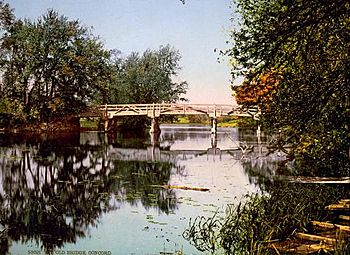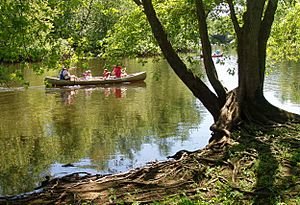Concord River facts for kids
Quick facts for kids Concord River |
|
|---|---|

The Concord River at the Old North Bridge, Concord, Massachusetts, circa 1900.
|
|
| Country | United States |
| Physical characteristics | |
| Main source | Sudbury and Assabet Rivers, Concord, Massachusetts 50 ft (15 m) 42°27′55″N 71°21′29″W / 42.4654°N 71.3580°W |
| River mouth | Merrimack River, Lowell, Massachusetts 42°38′47″N 71°18′09″W / 42.6465°N 71.3025°W |
| Length | 16.3 mi (26.2 km) |
| Basin features | |
| Basin size | 377 sq mi (980 km2) |
| Type: | Recreational |
| Designated: | April 9, 1999 |
The Concord River is a 16.3-mile (26.2 km) long river in eastern Massachusetts, United States. It flows into the Merrimack River. This river is famous in U.S. history. It was where an important early battle happened. A famous book by Henry David Thoreau was also written about it. The river flows through a mostly rural and suburban area northwest of Boston.
Contents
What is the Concord River?
The Concord River starts in Middlesex County. It is formed when the Sudbury and Assabet rivers meet. This meeting point is called Egg Rock, near the town center of Concord. The river generally flows north. It joins the Merrimack River in Lowell. The Concord River flows gently. It does not have many changes in its height along its path. Its drainage basin (the area of land that drains into the river) covers 36 towns in Massachusetts.
How did the Concord River get its name?
Long ago, Native Americans called this river the Musketaquid. This means "grass-grown" river. This name was given because the river's slow waters have many water plants. Its banks are also covered with wild grasses. This environment is good for many types of fish. These include bass, shad, alewife (river herring), pickerel, carp, and American eel. Native Americans used special woven sticks to catch alewives and other fish. These fish would travel up the rivers to lay their eggs.
By 1635, settlers from England arrived. They gave the river its current name, Concord River.
The Concord River and the American Revolution
On April 19, 1775, a famous event happened at the Old North Bridge over the river in Concord. This was the Battle of Concord. It happened on the same day as the first shots of the American Revolutionary War in nearby Lexington. Today, a copy of the bridge is kept by the National Park Service.
Henry David Thoreau and the River
Henry David Thoreau was a famous writer. He wrote his first book, A Week on the Concord and Merrimack Rivers, in 1849. He was living near Walden Pond at the time. His book tells about a seven-day boat trip he took with his brother John. Thoreau wrote about the river's natural beauty. He also shared his thoughts on important ideas like truth, poetry, and friendship. Even though the area around the river has grown, it is still a popular place for canoeing today.
Why did fish populations decrease?
Dams were built along the Concord River. These dams helped farmers grow more crops. They also provided power for mills. By the 1800s, the number of native shad and alewife fish dropped greatly. This happened because the dams stopped the adult fish from swimming upstream to lay their eggs.
Alewife and other anadromous fish are migratory. This means they travel. They hatch in fresh water. Then, they swim to the sea to grow. As adults, they return to fresh water to spawn (lay eggs). They usually go back to where they were born. When the dams blocked their path, their life cycle was broken. The Faulkner Dam in North Billerica was one of many dams that caused the alewife population to crash. Water was also sent from this point to run the Middlesex Canal.
How pollution affected the river
During the 1800s, the Concord River was in an important area for the Industrial Revolution in the U.S. Industries like textile, paper, tanning, and mining grew. Waste from these industries was dumped into the river. This included untreated sewage and other organic waste. Industrial growth in the river's area was highest in the 1920s. In the early 1960s, more chemical and metal companies appeared. Many of these supported the electronics industry near Boston. By the 1960s, the Merrimack River, which the Concord River flows into, was one of the most polluted rivers in America.
Cleaning up the river
In 1972, the Clean Water Act was passed. This law started efforts to make U.S. waterways cleaner. It put stricter rules on what could be dumped into rivers. This led to three wastewater treatment plants being built along the Concord River. One is in Concord and two are in Billerica. These plants have helped protect the river's ecosystem.
However, some pollutants still remain. These include heavy metals and PCBs. These are trapped in the river's mud. Because of mercury in the mud from old industrial sites, people are not allowed to eat fish caught in parts of the Sudbury River and downstream into the Concord River.
Recent pollution concerns
In 2004, a chemical called Perchlorate was found in the Concord River. At first, people thought it came from materials used in building roads. But an investigation found that a local company was using perchloric acid in a process. The water used to rinse things was going into the sewage system. Once the company was identified, they stopped their work. They installed special equipment to clean the water before it was released.
In 2007, the town of Billerica had to pay a large fine. This was because they were releasing too many pollutants into the Concord River. These pollutants included phosphorus, fecal coliform bacteria, and ammonia. The town's release of phosphorus caused too much plant growth in the river. This harmed the river's health.
Helping fish return to the river
In May 2000, different groups worked together to help fish return. They released 7,000 adult alewife (river herring) into the Concord River. These fish were moved from another river. The goal was for them to lay their eggs and spawn upstream. This would teach the young alewives to think of the Concord as their home river. However, this experiment did not work as planned. Not enough fish returned to the first dam on the Concord River.
A new study in 2016 is looking again at how to help diadromous fish return to the Concord River. Diadromous fish are those that travel between fresh and salt water. This group includes anadromous fish like alewives and shad, which live in salt water but lay eggs in fresh water. It also includes fish like eels, which live in fresh water but go to salt water to lay eggs.


